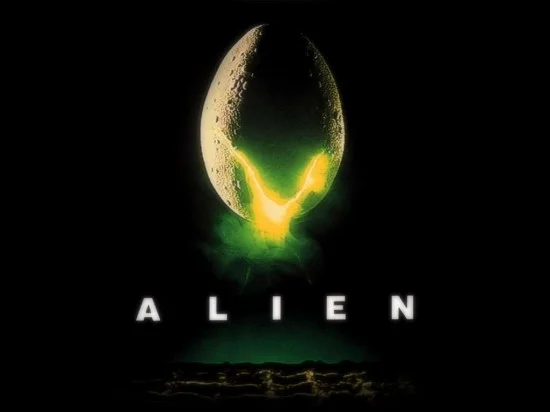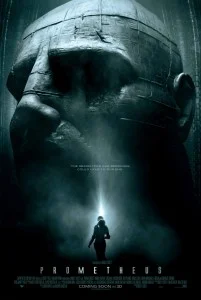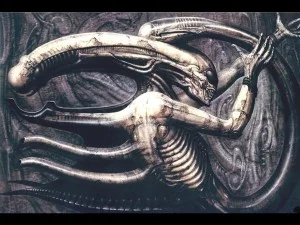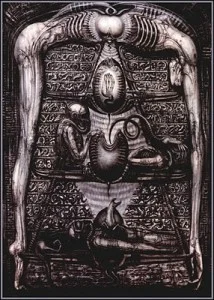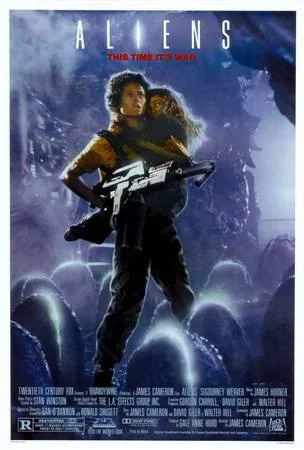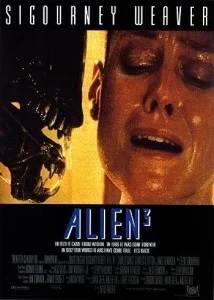Endless Forms Most Brutal
/At their king’s behest, four grizzled blind men approach an unidentified object. He warns them that it has lain forgotten in an unforgiving place, and is a putrid, clammy thing. They nod, not daring to remind the king which sense they lack. Standing almost nine feet tall, the object forces each man to claim his own portion.
The first man, at the object’s rear, says, “It has a knobby trunk, out of which smooth, hollow tubes run. It must be a sculpture.” Caressing its top, the second man partially agrees. “A sculpture yes, but not an object. It is a soldier, wearing a large helmet, pocked and ridged with the scars of battle.” The third man, who’s been kneeling, waves a finger. “But it is long and jagged, like the skeleton of some legendary beast.” The king smiles. The fourth man does not. He has the misfortune of standing directly in front of the thing. Before he can speak, it wraps a pair of six-fingered claws around his head. The other men hear hissing before hot blood splashes them.
Science fiction fans know this sculptured beast as an Alien, which has starred in four films since 1979, co-starred in two more, and has been licensed to spin-off in novels, comic books and video games since 1992. For this, we have the extraordinary talents of Ridley Scott (director of the original Alien) and James Cameron (Aliens, 1986) to thank. Their dedication to quality storytelling provided the creature with a foundation so fertile that embellishment seemed inevitable. The Dark Horse Comics series Labyrinth (1996), for example, explored in detail the Alien’s telepathic potential and vulnerability to disease. The publisher’s original comics run (1988-90) went straight for the jugular, depicting what no film has: an Earth overrun by Aliens.
Sadly, more recent pop-culture pollination has brought diminishing returns. Sophomoric humor, glossy computer effects, and tussles with the Predator, another sci-fi baddie from the 80s, have chipped the Alien’s savage veneer. Scott (who also directed Blade Runner, Thelma & Louise and Gladiator) is likely to bring some artistic gravitas back to the film franchise with June’s Prometheus. Once a craftsman of sleek commercials, Scott has teasingly said that this prequel includes “strands of Alien‘s DNA.”
Then again, maybe we all do. What the blind men couldn’t know is that the Alien is humanoid (but for a tail and banana-shaped head), without eyes or a nose, and covered in black corrugations that are more armor than flesh. Harming it, piercing the armor, releases bright yellow acid. Being harmed by it means a toothed rod flying from its mouth into your skull. In the hands of the wrong director, these grisly specifications are B-movie fodder. The original Alien story, in which homeward bound space-truckers detour to investigate a beacon, and then accidentally bring aboard something deadly, was in fact screenwriters Dan O’Bannon and Ron Shusett’s homage to films like It! The Terror from Beyond Space (1958) and The Thing From Another World (1951). Both feature claustrophobic environs, pacing that picks off characters one by one, and utterly ridiculous monstrosities.
On screen and up close, clear slime running down its chin, the Alien is one of the most elaborate atrocities we’ve ever met. Key to its leap from rubber-suited footnote to horror icon, however, is that O’Bannon and Shusett’s script started with no creature. They focused more on creating menacing atmospherics that would recalibrate the space monster genre along the lines of Jaws (1975) and The Texas Chainsaw Massacre (1974), which offered stark violence after long periods of unease. Then, inspired by a dream, Shusett conceived the risque idea of inter-species rape; their creature would plant a seed inside the living human victim, and its spawn would burst forth after a gestation period, killing the host.
Once again, an idea more likely to provoke laughter than terror. O’Bannon badly wanted to avoid this. The creature in his previous film, Dark Star (1974), was a spray-painted beach ball. Luckily, he’d met Swiss surrealist painter H.R. Giger in 1975, while working on a film adaptation of Frank Herbert’s Dune (which fell through financially). Ridley Scott, who sank his own teeth deep into the script by drawing storyboards (and getting his budget doubled from 4.2 to 8.4 million in the process), loved Giger’s dark, exquisite work. He commissioned the artist to design the Alien’s four stages of life: egg, facehugger, chestburster and adult- and the planetoid on which it is found, LV 426.
Scott, and the three directors to follow him in conjuring the Alien, were not blind like the grizzled villagers. They were tasked, however, with groping forward into the cavernous human psyche and returning with a terrible bounty. Giger’s book of paintings, Necronomicon, pointed the way. In describing it, poetic understatement must be cast aside. The works within are insane, nightmarish and sexually unsettling. The painting Necronom IV, from which the Alien was adapted, shows a pale figure with flesh that’s seamed and distended in its bondage with tubes of various sizes. There is also evidence of rot, as if a machine frame, organized from within the living thing, stretched it to its physical limits, killing it in the process. Other paintings, like Anima Mia and Hieroglyphics, show multiple organisms that have grown or melted across a mechanical surface, and sometimes back into each other. Eyes and teeth imbed in bone-covered walls. Knuckles line up beyond that familiar five that we humans find so comforting, sprouting spidery fingers. And, when you’ve stared almost long enough, fetal figures and genitalia appear.
“Biomechanics” is Giger’s name for the theme pervading his oeuvre, and it contrasts incredibly with the industrial astro-tech of Alien‘s storyboards. In drawing them, Scott was influenced by the films 2001: A Space Odyssey, Star Wars, and the French comic magazine Heavy Metal, which featured the immense, exotic art of Jean Giraud. In Alien, the realizations of each motif work like magician’s hands; the bright white interiors of the ship Nostromo entrance, and the phallic presence of Giger’s creations unnerve. This is never more true than in the scene where characters Dallas, Kane and Lambert explore the barren rock LV 426. They discover a derelict spacecraft that is asymmetrical, sensual and astonishingly huge. Inside, a being known as the “space jockey” sits dead in an enormous device that could be either gun or pilot’s chair. Then, like the first syllable of an incantation, Scott zooms in on a strange wound that seems to indicate something burst free of the jockey’s body. The scene ends with Kane (played by John Hurt) exploring the chamber below and finding hundreds of leathery urns. He learns too late that they’re eggs, as one peels open and a crab-like facehugger leaps for his helmet.
The rest is cinematic history. Twitchy science officer Ash (Ian Holm) allows Kane back aboard the Nostromo, and they head for Earth. The facehugger- doing just that- eventually falls off, but not before an attempt to remove it reveals that it bleeds acid. Later, during a meal, a seemingly healthy Kane begins choking and seizing. Lieutenant Ellen Ripley (Sigourney Weaver’s not yet legendary character) joins everyone in holding him down. When the chestburster, the worm-like juvenile Alien, explodes from him, a strangled, “Oh God,” escapes Lambert (Veronica Cartwright), whom Scott didn’t warn about the spray of blood.
Most Alien fans are also born during this moment. It’s the top of the tracks before the roller coaster drops, and the crew is slaughtered one by one. Additionally, there is a jarring spiral which further justifies the film’s cult following, and it involves Ian Holm’s character. After Dallas, captain of the Nostromo, is dragged off by the Alien, Ripley takes charge. She discovers that the company employing her wants the organism for study, and the ship’s crew is expendable. Ash, being the science officer, knew the secret, and offers Ripley no sympathy. When she slaps him, he shuts several doors electronically, denying her access to most of the rest of the ship. The stress of the situation causes Ripley’s nose to bleed. With eerie symmetry, Scott shows white fluid running down Ash’s temple. The science officer then throws Ripley down and tries to shove a rolled up magazine down her throat. He’s revealed to be an android when Parker (Yaphet Kotto) returns and bashes his head off with a fire extinguisher. White fluid fountains everywhere.
No music pillows the horror of Ripley’s struggle in this scene. It takes place in the bunk area, where cutouts of busty women are the wallpaper behind Ash’s rapacious act. It is also the first comment on the Alien being exactly as vicious as it looks (a monolith of black glass, in Scott’s hands), while humans, able to hide behind any number of masks, are just as deadly. Later, with some repaired wiring, Ash even says that he, “Admires [the Alien’s] purity.”
That mankind and the Alien stand on opposite sides of a mirror, reflecting each other, proved an irresistible theme for James Cameron. In his muscular sequel Aliens, he embellished not only Ripley’s employer, the Weyland-Yutani Corporation, but also the Alien and its life-cycle, by introducing the Queen. The film opens with Ripley drifting through space in an escape craft, asleep in stasis after blowing up the Nostromo and blasting the Alien from the airlock. A salvage crew rescues her, bringing her aboard the Gateway space station, where a Weyland-Yutani representative awaits her. “I’m Burke,” says Paul Reiser, “Carter Burke. I’m with the company, but don’t let that fool you. I’m really an okay guy.” He also tells her that she floated through space for fifty-seven years.
Devastated, Ripley nevertheless finds herself answering to a council of bureaucrats for the very expensive Nostromo‘s destruction. They gloss over her testimony regarding the Alien and any orders to retrieve it from LV 426. When she insists that proof of her tale is still on the planetoid, she’s snidely told that atmosphere engineers and their families already live there, with no complaints about a “hostile organism.”
The pencil-pushers soon discover that no news isn’t good news. They lose contact with the colony and, under the circumstances, decide to send in marines. Ripley agrees to join them as an “advisor” (a term freighted with Cold War cynicism), if only to assuage her nightmares of the Alien. Carter Burke and the android Bishop (Lance Henriksen) round out the squad returning to LV 426. Once planet-side, they find abandoned living structures and labs where facehuggers have been studied. They also find a young girl, Newt, who’s the only survivor of the “monsters.”
The film’s second act sees Cameron polish the mirror, bringing mankind and the Alien ever closer. When the marines learn that dozens of colonists survive in a nearby nuclear facility, they deploy forcefully to rescue them. But before they find people, they enter a hot, smelly labyrinth, lined with a resinous material reminiscent of bone. Eventually, the colonists appear glued to the wall at regular intervals, like factory-farmed pigs. When an infant Alien bursts from the chest of a delirious woman who begs for death, the film begins its relentless throttle to the end. Acid sizzles across armor. Blood smears windshield glass.
As the second blind man guessed, these Aliens are soldiers. Unlike the single, statuesque terror in the first film, they swarm by the dozen and sacrifice themselves to the marines’ pulse rifles. And here, as in Terminator 2 (1991) and Titanic (1997), Cameron balances the action with brains. His Aliens are drones. Their frenzied fighting protects the hive of their Queen.
The likeness to ants and termites is intentional. That the facehuggers hatch from eggs hops neatly to the question, “What lays them?” Near the film’s end, we meet Cameron’s Alien Queen, which is an awe-inspiring physical effect, more intimidating than any computer generated image. She’s larger than her drones, longer in the tooth, gifted with extra arms, and her skull branches out into a flat, gleaming black carapace. The first part we see, however, is her elongated egg-sack, strapped in support to the ceiling, as it plops down one more leathery urn among hundreds. With most of the marines dead or injured, Ripley carries bullets, grenades and a flamethrower (so much for merely advising) to rescue Newt, who’s been lost in the hive. As the pair sneak through the egg chamber, a few open. Torching them riles the Queen, who commands her drones to attack. But when Ripley threatens the entire clutch, the monstrosity proves canny enough to let them pass. Our heroine knows better. She bombs the egg-sack and incinerates everything else.
The conduit of Cameron’s imagination propelled Ripley to iconic status alongside the Alien, and cemented his vision to that of the franchise. The comics of the early 90s sprang directly from Aliens and used Cameron’s survivors Newt and Hicks (Michael Biehn) to explore more ambitious tales, such as the above mentioned Outbreak trilogy (by Mark Verheiden), in which religious cultists steal a Queen, give themselves to her, and precipitate an Alien takeover of Earth. Other comic series, such as Genocide (1991) and Hive (1992), are likewise unmoored from the budgetary realities of film. They offer scenarios that quickly drill to the core of humanity’s relationship with not just the Alien, but with everything that lives. Genocide (written by John Arcudi, drawn by Damon Willis) shows us a pharmaceutical company that’s stolen royal jelly from an Alien Queen and created the drug xeno-zip. In this tale, the substance enhances a human’s physical prowess and is worth a fortune. In Hive (written by Jerry Prosser, drawn by Kelley Jones), the same substance proves psychotropic and addictive, prompting a rogue scientist to create an Alien android that can infiltrate a Queen’s lair and steal it for him.
Like the films, these comics hinge on the Alien’s mystique as something that can’t be tamed or properly studied. Unlike every species of rhinoceros, and even the polar ice caps, this creature is able to deny humanity its craving to bend all that lives to its will. In his 2012 book Life Everlasting, which deals with the balanced give-and-take that is common sense among most Earthlings, scientist Bernd Heinrich sketches humankind with bleak accuracy:
We are the ultimate scavengers of all time. Everything from the coal forests to a large part of the earth’s animal biomass- domestic birds and mammals (and increasingly, fish)- are cycled directly into us, instead of into a sustainable world ecosystem. So far there is little evidence of conscious effort to stop “growth.” People… still don’t viscerally realize that there are limits to human population that must be adhered to whether or not we as individuals choose to do so.
In the Aliens Universe, little detail is given about how space travel and the settling of other planets become commercialized. We do know that mega-corporation Weyland-Yutani considers people expendable, and solves its problems with colonial marines (much like oil concern Halliburton does with Blackwater mercenaries in the Middle East). Given the tone of the franchise, in which chocolate and cigars are rare, and artificial humans are a legitimate industry, the future is likely to be achieved at the expense of our planet. Prometheus, set thirty years before Ripley’s Nostromo voyage, promises a glimpse.
And, returning to Ripley, we can appreciate that the spin-offs are intriguing, but their profusion made Alien 3 (1992) difficult to film. Cameron spoiled viewers with incredible plotting and action, and 20th Century Fox knew that a sequel’s success or failure could take the entire franchise with it. Enter the third blind man, perfectionist David Fincher (who’s since directed Se7en, Fight Club and The Social Network).
Prior to being brought in late to save a film which several creators had abandoned, Fincher had only ever done commercials and music videos. After a gantlet of his own creative tribulations (studio meddling, that is, which resulted in a falling out with H.R. Giger), he began shooting without a finished script. It was also a script that changed the setting from a planetoid that was a wooden monastery, to a larger planet that had a refinery-turned-prison.
Despite these absurdities, Fincher’s directorial debut soars on rusty atmospheric dread, with excellent acting and dialogue. Here is Charles S. Dutton, one of the few non-British actors in Alien 3, eulogizing Newt and Hicks, who were spared by Cameron only to die when their ship Sulaco crashes on Fury 161:
Why? Why are the innocent punished? Why the sacrifice? Why the pain? There aren’t any promises. Nothing’s certain. Only that some get called, some get saved. She won’t ever know the hardship and grief for those of us left behind. We commit these bodies to the void with a glad heart. For within each seed, there is a promise of a flower. And within each death, no matter how small, there’s always a new life. A new beginning.
Wrapped in linen, the bodies are dropped into a vat of molten lead. All the while an Alien, in the refinery’s bowels, breaks through the chest of a rottweiler. It kills a large cast faster, more violently, than Scott’s first Alien. The prisoners call it the “beast” and the “dragon.” Not once, however, does it harm Ripley. This is because, after all this time, she finally harbors an Alien herself. In the end, when she decides to jump into the molten lead to keep it from Weyland-Yutani, her story comes to a nihilistic, though satisfying, end.
Yet many people hate Alien 3. It’s intimate, it takes place on a backward world with few sci-fi elements, and its characters exchange reams of tense, cerebral dialogue as if in a stage play. If Fox had only waited to continue the franchise under more favorable conditions- most obviously, with a director whose pedigree precluded studio interference- then maybe a prison drama wouldn’t have been inflicted on legions of action fans.
In choosing French director Jean-Pierre Jeunet to helm Alien: Resurrection (1997), Fox hoped to win forgiveness. His previous films Delicatessen (1991) and The City of Lost Children (1995) are whimsical, visually stunning black comedies. That the Alien murdered the fourth blind man, before he could even describe what he touched, should be telling. Jeunet could not have been a worse choice to continue the franchise, and screenwriter Joss Whedon details why:
It wasn’t a question of doing everything differently, although they changed the ending; it was mostly a matter of doing everything wrong. They said the lines… mostly… but they said them all wrong. And they cast it wrong. And they designed it wrong. And they scored it wrong. They did everything wrong that they could possibly do. There’s actually a fascinating lesson in filmmaking, because everything that they did reflects back to the script or looks like something from the script, and people assume that, if I hated it, then they’d changed the script…but it wasn’t so much that they’d changed the script; it’s that they just executed it in such a ghastly fashion as to render it almost unwatchable.
A scene exemplifying Whedon’s diagnosis features an Alien thrusting its toothed rod into the back of actor Dan Hedaya’s head. This is exactly what we’ve paid to see, until Hedaya pauses to remove a chunk of his own brains like a cartoon character. He then keels over, eyes crossed.
A more fundamental problem with Alien: Resurrection, is that Ripley’s tale had ended. Studio greed (echoing that of Weyland-Yutani itself) insisted she be cloned and an Alien Queen taken from her chest. By the end of an idiotic, bullet-riddled ninety minutes, Weaver’s once admirable heroine has participated in a drone orgy, which inscrutably results in an Alien/human hybrid (nowhere in Whedon’s script). This rubber-suited footnote bursts from the Queen’s bloated belly, kills once or twice for good measure, and then is ushered off-screen in as laughable a manner as it’s introduced: sucked into space through a teacup-sized hole.
Ironically, the Alien/human hybrid is a concept many of the comics alluded to, but none dared realize. Wouldn’t it, after all, flatten our complex relationship with the creature by discarding the very definition of alien? Without the mirror, the corporation becomes the hive, and all of us, the drones.
As an optimist, I’d like to think we’re a different mankind, one that wants a habitable home in the next hundred years. We should be eager to live with the Earth, beholden to each and every other species, and not just on it, like a bacteria-laden boil. In his essay “Who Swims with the Tuna” naturalist David Quammen puts the sentiment this way:
…dolphins have an unmatched appeal to us humans. From our point of view, it’s a special kinship. They are bright, sophisticated, cheery, generous, perceptive, affectionate, and yet mysterious- all the things we value in our friends. They seem to possess important secrets. They seem to reciprocate our infatuation. Plus, they consent to let us swim with them.
On the other hand, who swims with the tuna? The answer is that the dolphins do.
Acknowledging the intrinsic value all living things, sentient by our standards or not, should be our highest priority. Otherwise, we’ll become a galactic culture for whom the ends justify the means. We’ll physically reach other planets with To Plunder still on the menu of acceptable reactions. And we’ll eventually discover that, like our own biosphere, the cosmos is a living system, capable of reaction when pushed.
It’d be hard to create a better antibody than the Alien.
Justin Hickey was an editor at Open Letters Monthly, and writes regularly for Kirkus Reviews.
